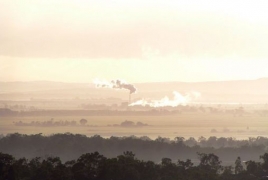Antarctic ozone hole beginning to heal, new study finds July 1, 2016 - 10:08 AMT PanARMENIAN.Net - Decades after the fog from hairspray and deodorant cans dissipated in a worldwide ban, the results are finally paying off for the Earth's protective layer: The ozone hole over the Antarctic is beginning to heal, a new study finds, according to USA Today. Located in the stratosphere, the ozone layer blocks potentially harmful ultraviolet energy from reaching our planet's surface. Without it, humans and animals could experience increased rates of skin cancer and other ailments. Researchers found the hole shrunk by more than 1.5 million square miles — about half the area of the contiguous United States — since 2000, when ozone depletion was at its peak. “It’s a big surprise,” said Susan Solomon, an atmospheric chemist at the Massachusetts Institute of Technology and lead author of the study published Thursday in the journal Science. “I didn’t think it (the healing) would be this early.” The discovery shows global attempts to improve Earth's environment can work, providing a template for how humanity could tackle the exponentially larger issue of climate change, Solomon said. The hole won't completely close for at least 30 years at the earliest but is opening up just a little bit less almost every year, Solomon said. Scientists first discovered the gaping dramatic thinning in Earth's protective sheet in the late 1950s and determined the production of chlorofluorocarbons (CFCs), used in refrigerators and aerosol sprays, caused the anomaly. In the late 1980s, 196 countries signed the Montreal Protocol, a treaty that limited production of CFCs around the world. The hole fluctuates in size from year to year and tends to be its largest after winter, which runs June to August in the Southern Hemisphere, and smallest after summer, December to February. The hole usually extends to its largest diameter in September or October. Scientists in this study said the best time to measure it is in September, when it's most influenced by the CFCs. Scientists also discovered that last year's record large ozone hole in October was a fluke mainly caused by a volcanic eruption in Chile six months earlier that temporarily disrupted the atmosphere's chemistry to such a degree that the hole extra-enlarged. Photo: Pixabay / Creative Commons Authorities said a total of 192 Azerbaijani troops were killed and 511 were wounded during Azerbaijan’s offensive. In 2023, the Azerbaijani government will increase the country’s defense budget by more than 1.1 billion manats ($650 million). The bill, published on Monday, is designed to "eliminate the shortcomings of an unreasonably broad interpretation of the key concept of "compatriot". The earthquake caused a temporary blackout, damaged many buildings and closed a number of rural roads. Partner news |